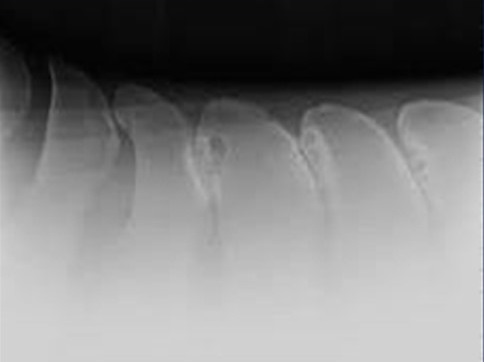
Kissing Spines
What are kissing spines?
Takeaways
- Overriding dorsal spinous processes, or “kissing spines”, occur when two or more bony projections at the top of the vertebrae (dorsal spinous processes) touch or overlap.
- The exact cause is not well understood and many horses with kissing spines do not show any clinical signs. In some cases, kissing spines are secondary to other health issues.
- Affected horses may undergo medical or surgical treatment and physical therapy.
- Recovery is possible, but requires time and commitment.
*Download a printable pdf of this article here.
Overriding (or impinging) dorsal spinous processes (ORDSP), or “kissing spines”, occur when vertebrae in the spine are too close together, rather than being spaced apart as in a healthy spine. This results in touching or overlapping of two or more of the bony projections at the top of each vertebrae (spinous processes). In some horses, this can cause consistent, low-grade pain, but many horses do not exhibit any clinical signs.
The locations and number of vertebrae involved can vary. Kissing spines most commonly occur between thoracic vertebrae (T) 13 and 18, with T15 the most often affected. This is the site where the angle of the dorsal spinal process changes orientation. It is also the site directly under the saddle and the rider’s seat. Kissing spines have also been observed in the lumbar vertebrae, but this is less common.
The presence of kissing spines is not necessarily cause for concern, but it can be a predisposing factor for back pain. Thoroughbreds and performance horses are the most commonly diagnosed cases. Kissing spines are likely acquired. They can be the result of a variety of factors, including poor saddle fit and improper training that allows the horse to carry itself with its head up, back hollow, and not engaging the muscles in its core. Genetic factors are possible, but none have been identified to date.
What are the clinical signs of kissing spines?
Many horses with mild kissing spines do not exhibit any clinical signs. For those that do, the signs can be highly variable and may include vague or overt lameness and overall poor performance. Affected horses can exhibit changes in behavior such as hypersensitivity to brushing, girthiness, bucking, rearing, head tossing, kicking out, hollowing the back, resisting the bit, trouble with transitions, cross-cantering, and refusing or rushing fences. Their backs are often sore to the touch.
How are kissing spines diagnosed?
A diagnosis can be challenging as it can be difficult to differentiate some of the clinical signs of kissing spines from behavioral or training issues, or medical conditions that are not related, or secondary, to the back. Radiographs (X-rays) are commonly used to diagnose kissing spines. However, it is important to perform a thorough clinical examination and not just rely on X-ray analysis. Thermography, which uses an infrared camera to detect heat patterns, has been shown to be informative in some cases. Bone scans (nuclear scintigraphy) and ultrasound may also be used to provide diagnostic information. Referral to a specialist may be warranted for an accurate diagnosis.

How are kissing spines treated?
Treatment for kissing spines begins with making the horse more comfortable. This may be achieved through pain reduction, muscle relaxation, and exercises to stretch and strengthen back and abdominal muscles, stabilize posture, and improve mobility. Medical treatments may include shockwave therapy of the affected vertebrae and surrounding muscles, injections of anti-inflammatories in the region of the kissing spines (mesotherapy), and corticosteroid injections in the spaces between the vertebrae.
Physical therapy may include daily exercises that encourage the horse to move freely in a relaxed frame and may progress to poles and cavaletti once the horse is willing to stretch. A Pessoa Lunging System may be used to encourage the horse to engage its core muscles. Exercise on an aqua treadmill may also be recommended. An assessment of saddle fit should also be performed and any necessary adjustments made to alleviate pressure points on the back. Chiropractic and acupuncture therapies, as well as therapeutic ultrasound, may also be utilized.
Surgical treatment is also an option in severe cases. One approach is to remove about half (3 inches) of the bone at the top of each of the dorsal spinous processes. This type of surgery is highly invasive and involves long recovery times. Alternatively, endoscopy may be used to remove selected dorsal spinous processes and rejoin the ligaments between the processes. Another option is to perform an interspinous ligament desmotomy (ISLD) in which the interspinous ligament(s) is cut to relieve tension on the ligament. This can be performed in a standing, sedated horse. Although surgical intervention can produce positive results, these approaches can also destabilize the back and can lead to future lameness.
What is the prognosis for kissing spines?
The presence of kissing spines is not necessarily a cause for concern, but it may be considered as a predisposing factor for back pain. The majority of affected horses that exhibit clinical signs are able to return to work with medical or surgical treatment and physical therapy. Sustained results often necessitate a multifaceted approach, which requires time and commitment. The prognosis is poorer for young horses (5 years of age or younger), horses with five or more vertebrae involved, and for cases in which kissing spines are secondary to other spinal issues.
How can kissing spines be prevented?
The exact cause of kissing spines is unknown but is thought to be related to conformation and development. It is important to treat potential underlying issues, such as other causes of lameness or improper saddle fit, first, as these may prevent horses from using their backs properly.
For more information:
UC Davis, School of Veterinary Medicine, Equine Integrative Sports Medicine Service: https://www.vetmed.ucdavis.edu/hospital/large-animal/equine-sports-med
UC Davis, School of Veterinary Medicine, Equine Surgery and Lameness Service: https://www.vetmed.ucdavis.edu/hospital/large-animal/equine-surgery-lameness
*This article may not be reproduced without the written consent of the UC Davis Center for Equine Health. Please email requests to cehadmin@ucdavis.edu.
